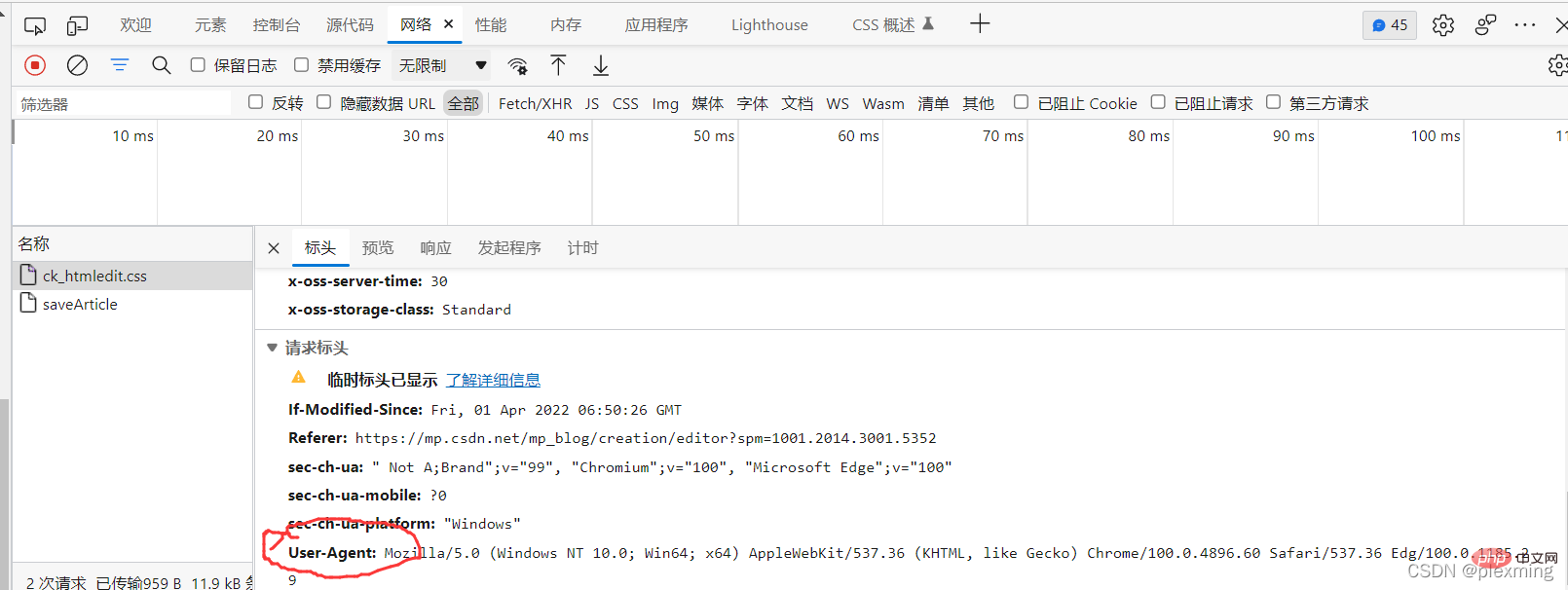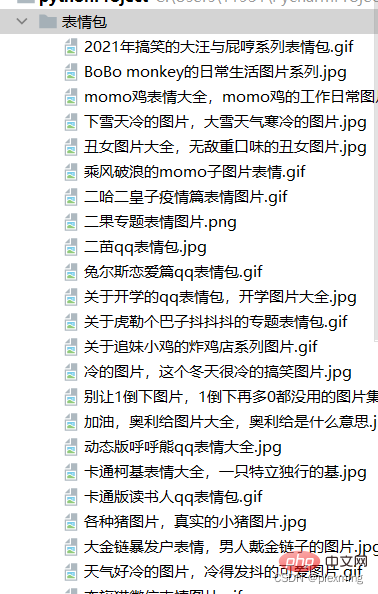Getting started with Python crawler: crawling web images
This article brings you relevant knowledge about Python, which mainly organizes the related issues of crawling web images. In order to obtain data efficiently, crawlers are very easy to use, and Using python to make a crawler is also very simple and convenient. Let’s take a look at the basic process of writing a crawler through a simple small crawler program. Let’s take a look at it together. I hope it will be helpful to everyone.

[Related recommendations: Python3 video tutorial ]
In this era of information explosion, if you want to obtain data efficiently, Crawlers are very useful. It is also very simple and convenient to use python to make a crawler. Let’s take a look at the basic process of writing a crawler through a simple small crawler program:
Preparation
Language: python
IDE: pycharm
The first is the library to be used, because it is the simplest program for just getting started. We mainly use the following two:
import requests //用于请求网页 import re //正则表达式,用于解析筛选网页中的信息
Among them re comes with python, and the requests library needs to be installed by ourselves. Just enter pip install requests on the command line.
Then find a random website. Be careful not to try to crawl privacy-sensitive information. Here is an emoticon package website:
Note: The content in the emoticon package website here can be downloaded for free. , so the crawler just simplifies our process one by one. Be careful not to crawl paid resources.

#What we have to do is download these emoticons to our computer through a crawler.
Writing a crawler program
First of all, you must access this website through python. The code is as follows:
headers = {
'User-Agent': 'Mozilla/5.0 (Windows NT 10.0; Win64; x64; rv:98.0) Gecko/20100101 Firefox/98.0'
}
response = requests.get('https://qq.yh31.com/zjbq/',headers=headers) //请求网页The reason why you need to add the headers section is because some web pages will recognize you It is requested through python and then rejected, so we need to change the normal request header. You can find one at random or use f12 to copy one from the network information.

Then we need to find the location of the image we want to crawl in the web page code. Check the source code with f12 and find the emoticon package as follows:

Then create a matching rule and replace the middle string with a regular expression. The simplest one is.*?
t = '<img src="(.*?)" alt="(.*?)" width="160" height="120">'
Like this.
Then you can call the findall method in the re library to crawl down the relevant content:
result = re.findall(t, response.text)
The returned content is a list composed of strings. Finally, we crawled to the address through python Just download the image and save it to a folder.
Program code
import requests
import re
import os
image = '表情包'
if not os.path.exists(image):
os.mkdir(image)
headers = {
'User-Agent': 'Mozilla/5.0 (Windows NT 10.0; Win64; x64; rv:98.0) Gecko/20100101 Firefox/98.0'
}
response = requests.get('https://qq.yh31.com/zjbq/',headers=headers)
response.encoding = 'GBK'
response.encoding = 'utf-8'
print(response.request.headers)
print(response.status_code)
t = '<img src="(.*?)" alt="(.*?)" width="160" height="120">'
result = re.findall(t, response.text)
for img in result:
print(img)
res = requests.get(img[0])
print(res.status_code)
s = img[0].split('.')[-1] #截取图片后缀,得到表情包格式,如jpg ,gif
with open(image + '/' + img[1] + '.' + s, mode='wb') as file:
file.write(res.content)The final result is like this:

Python3 video tutorial]
The above is the detailed content of Getting started with Python crawler: crawling web images. For more information, please follow other related articles on the PHP Chinese website!

Hot AI Tools

Undresser.AI Undress
AI-powered app for creating realistic nude photos

AI Clothes Remover
Online AI tool for removing clothes from photos.

Undress AI Tool
Undress images for free

Clothoff.io
AI clothes remover

Video Face Swap
Swap faces in any video effortlessly with our completely free AI face swap tool!

Hot Article

Hot Tools

Notepad++7.3.1
Easy-to-use and free code editor

SublimeText3 Chinese version
Chinese version, very easy to use

Zend Studio 13.0.1
Powerful PHP integrated development environment

Dreamweaver CS6
Visual web development tools

SublimeText3 Mac version
God-level code editing software (SublimeText3)

Hot Topics
 1393
1393
 52
52
 37
37
 110
110
 PHP and Python: Different Paradigms Explained
Apr 18, 2025 am 12:26 AM
PHP and Python: Different Paradigms Explained
Apr 18, 2025 am 12:26 AM
PHP is mainly procedural programming, but also supports object-oriented programming (OOP); Python supports a variety of paradigms, including OOP, functional and procedural programming. PHP is suitable for web development, and Python is suitable for a variety of applications such as data analysis and machine learning.
 Choosing Between PHP and Python: A Guide
Apr 18, 2025 am 12:24 AM
Choosing Between PHP and Python: A Guide
Apr 18, 2025 am 12:24 AM
PHP is suitable for web development and rapid prototyping, and Python is suitable for data science and machine learning. 1.PHP is used for dynamic web development, with simple syntax and suitable for rapid development. 2. Python has concise syntax, is suitable for multiple fields, and has a strong library ecosystem.
 Can visual studio code be used in python
Apr 15, 2025 pm 08:18 PM
Can visual studio code be used in python
Apr 15, 2025 pm 08:18 PM
VS Code can be used to write Python and provides many features that make it an ideal tool for developing Python applications. It allows users to: install Python extensions to get functions such as code completion, syntax highlighting, and debugging. Use the debugger to track code step by step, find and fix errors. Integrate Git for version control. Use code formatting tools to maintain code consistency. Use the Linting tool to spot potential problems ahead of time.
 Can vs code run in Windows 8
Apr 15, 2025 pm 07:24 PM
Can vs code run in Windows 8
Apr 15, 2025 pm 07:24 PM
VS Code can run on Windows 8, but the experience may not be great. First make sure the system has been updated to the latest patch, then download the VS Code installation package that matches the system architecture and install it as prompted. After installation, be aware that some extensions may be incompatible with Windows 8 and need to look for alternative extensions or use newer Windows systems in a virtual machine. Install the necessary extensions to check whether they work properly. Although VS Code is feasible on Windows 8, it is recommended to upgrade to a newer Windows system for a better development experience and security.
 Is the vscode extension malicious?
Apr 15, 2025 pm 07:57 PM
Is the vscode extension malicious?
Apr 15, 2025 pm 07:57 PM
VS Code extensions pose malicious risks, such as hiding malicious code, exploiting vulnerabilities, and masturbating as legitimate extensions. Methods to identify malicious extensions include: checking publishers, reading comments, checking code, and installing with caution. Security measures also include: security awareness, good habits, regular updates and antivirus software.
 Python vs. JavaScript: The Learning Curve and Ease of Use
Apr 16, 2025 am 12:12 AM
Python vs. JavaScript: The Learning Curve and Ease of Use
Apr 16, 2025 am 12:12 AM
Python is more suitable for beginners, with a smooth learning curve and concise syntax; JavaScript is suitable for front-end development, with a steep learning curve and flexible syntax. 1. Python syntax is intuitive and suitable for data science and back-end development. 2. JavaScript is flexible and widely used in front-end and server-side programming.
 PHP and Python: A Deep Dive into Their History
Apr 18, 2025 am 12:25 AM
PHP and Python: A Deep Dive into Their History
Apr 18, 2025 am 12:25 AM
PHP originated in 1994 and was developed by RasmusLerdorf. It was originally used to track website visitors and gradually evolved into a server-side scripting language and was widely used in web development. Python was developed by Guidovan Rossum in the late 1980s and was first released in 1991. It emphasizes code readability and simplicity, and is suitable for scientific computing, data analysis and other fields.
 How to run programs in terminal vscode
Apr 15, 2025 pm 06:42 PM
How to run programs in terminal vscode
Apr 15, 2025 pm 06:42 PM
In VS Code, you can run the program in the terminal through the following steps: Prepare the code and open the integrated terminal to ensure that the code directory is consistent with the terminal working directory. Select the run command according to the programming language (such as Python's python your_file_name.py) to check whether it runs successfully and resolve errors. Use the debugger to improve debugging efficiency.




